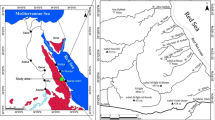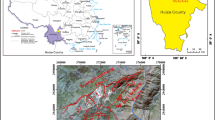Abstract
The principal uses of Landsat imagery in volcanological studies are for regional reconnaisance, for the interpretation of large volcanic structures and to facilitate the comparison of structures in different parts of the world. Standard black and white single band prints and standard false colour composites are the cheapest and most readily available forms of Landsat imagery. However, standard Landsat images have a poorer resolution and lower information content than enhanced images. The most generally useful enhancement techniques for volcanic studies have proved to be destriping. contrast stretching and edge enhancement. Enhancement techniques are illustrated with examples of young volcanic structures from the Central Andes. The next few years should see significant advances in satellite remote sensing technology with higher resolution imagery (down to 10–30m) and imagery in a wider range of spectral bands becoming available.
Similar content being viewed by others
References
Abrams, M. I.: 1980, ‘Lithologic Mapping’, in Siegal, B. S. and Gillespie, A. R. (eds):Remote Sensing in Geology, Wiley, New York, p. 702.
Baker, M. C. W.: 1982, ‘The Nature and Distribution of Upper Cenozoic Ignimbrite Centres in the Central Andes’,J. Volcanol. Geotherm. Res. 11, 293–315.
Batson, R. M., Edwards, K., and Eliason, E. M.: 1976, ‘Synthetic Stereo and Landsat Pictures’,Photog. Eng. R.S. 42 (10), 1279–1284.
Briggs, I.: 1981, ‘Integration of Elevation Data with Remotely Sensed Data’, in Laut, P. (ed),Landsat 81. Proceedings of the Second Australian Remote Sensing Conference, Canberra 1981, 4.1.1–4.1.4.
Gillespie, A. R.: 1980, ‘Digital Techniques of Image Enhancement’, in Siegal, B. S. and Gillespie, A. R. (eds.)Remote Sensing in Geology, Wiley, New York, p. 702.
Lowman, P. D.: 1980, ‘The Evolution of Geological Space Photography’, in Siegal, B. S. and Gillespie, A. R. (eds.),Remote Sensing in Geology, Wiley, New York, p. 702.
Ruiz, R. M., Elliot, D. A., Yagi, G. M., Pomphrey, R. B., Power, M. A., Farrell, K. W., Lorre, J. L., Benton, W. D., Dewar, R. E. and Cullen, L. E.: 1977, ‘IPL Processing of the Viking Orbiter Images of Mars’,J. Geophys. Res. 82, 4189–4202.
Sabins, F. F.: 1978,Remote Sensing-Principles and Interpretation, Freeman, San Francisco, p. 426.
Schaber, G. G., Elachi, C., and Farr, T. G.: 1980, ‘Remote Sensing Data of SP Mountain and SP Lava Flow in North-central Arizona’,Rem. Sens. Environ. 9, 149–170.
Short, N. M., Lowman, P. D., Freden, S. C., and Finch, W. A.: 1976, ‘Mission to Earth: Landsat Views the World’, NASA, Washington, D.C., p. 459.
Siegal, B. S. and Gillespie, A. R. (eds): 1980,Remote Sensing in Geology, Wiley, New York, p. 702.
Author information
Authors and Affiliations
Rights and permissions
About this article
Cite this article
Baker, M.C.W. Contribution of landsat imagery to the study of volcanic structures. Geophysical Surveys 5, 281–293 (1982). https://doi.org/10.1007/BF01454019
Issue Date:
DOI: https://doi.org/10.1007/BF01454019




